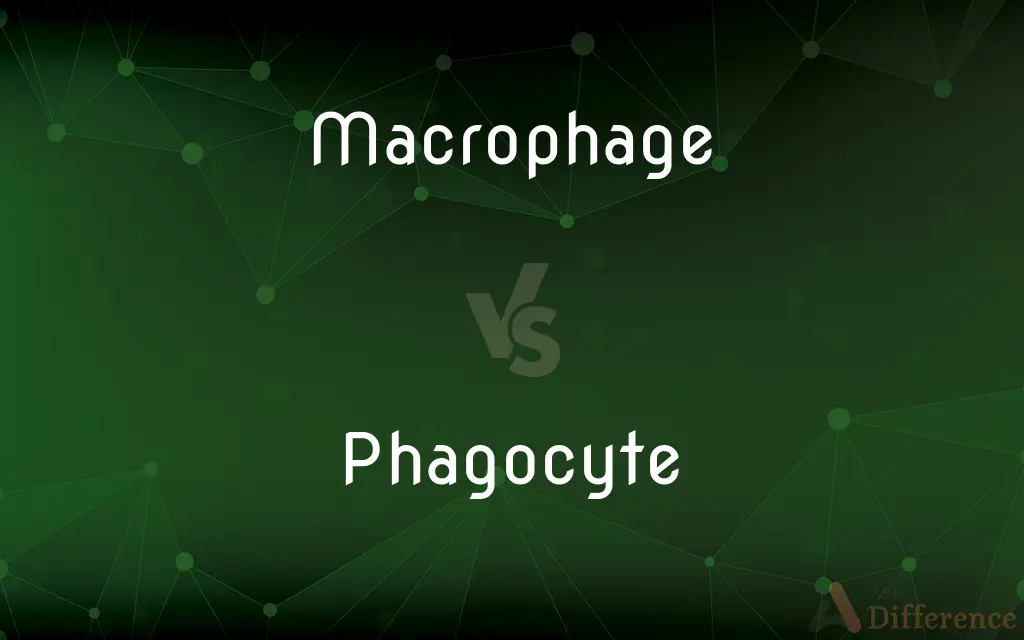Macrophage vs. Phagocyte — What's the Difference?
By Fiza Rafique & Maham Liaqat — Updated on April 2, 2024
Macrophages are a specific type of phagocyte that play a key role in immune response, while phagocytes refer to a broad class of cells that engulf and digest pathogens.

Difference Between Macrophage and Phagocyte
Table of Contents
ADVERTISEMENT
Key Differences
Macrophages are specialized phagocytes that remain in tissues and are pivotal in initiating the immune response by presenting antigens to T cells, whereas phagocytes are a general category of immune cells, including neutrophils and macrophages, that ingest and destroy pathogens through phagocytosis.
Macrophages are known for their role in tissue repair and remodeling, releasing factors that promote healing, while phagocytes like neutrophils often lead the first line of defense against infections, rapidly responding to invaders in a nonspecific manner.
Macrophages have the unique ability to activate adaptive immunity by presenting antigens to lymphocytes, emphasizing their role in bridging innate and adaptive immune responses, whereas other phagocytes primarily participate in the innate immune response, focusing on immediate pathogen clearance.
The lifespan of macrophages can vary from months to years, allowing them to contribute to long-term immunity and tissue homeostasis, while phagocytes like neutrophils have a much shorter lifespan, usually only a few days, highlighting their role in acute responses.
Macrophages are highly versatile, capable of assuming different functional states based on signals from their environment, whereas phagocytes such as neutrophils and eosinophils are more uniform in function, primarily targeting and eliminating pathogens.
ADVERTISEMENT
Comparison Chart
Type
Specific type of phagocyte
Broad class of immune cells
Role in Immune System
Initiates immune response, tissue repair
Engulfs and destroys pathogens
Lifespan
Months to years
Days to weeks
Immunity Type
Bridges innate and adaptive immunity
Primarily innate immunity
Functional Versatility
Highly versatile, can change function
Generally uniform in function
Compare with Definitions
Macrophage
A type of white blood cell that plays a significant role in immunity.
Macrophages are crucial for both innate and adaptive immunity.
Phagocyte
A cell capable of engulfing and absorbing bacteria and other small cells and particles.
Phagocytes rapidly respond to infection by engulfing pathogens.
Macrophage
Cell involved in tissue repair and remodeling.
After surgery, macrophages help with the healing process by removing dead cells.
Phagocyte
A general term for cells that protect the body by ingesting harmful foreign particles.
Neutrophils, a type of phagocyte, are abundant in the bloodstream.
Macrophage
Immune cell that engulfs and digests cellular debris, foreign substances, and pathogens.
Macrophages in the wound area help clean up debris and fight infection.
Phagocyte
Plays a primary role in the innate immune response.
Phagocytes are among the first cells to arrive at an infection site.
Macrophage
Long-lived immune cell that contributes to tissue homeostasis.
Macrophages in the liver help maintain organ function by removing toxins.
Phagocyte
Includes various types such as neutrophils and macrophages.
Different phagocytes are specialized for various pathogens.
Macrophage
Antigen-presenting cell that activates T cells.
Macrophages present antigens to T cells, triggering an immune response.
Phagocyte
Crucial for the body's defense against infections.
Phagocytes help prevent the spread of infection by engulfing bacteria.
Macrophage
A large phagocyte.
Phagocyte
Phagocytes are cells that protect the body by ingesting harmful foreign particles, bacteria, and dead or dying cells. Their name comes from the Greek phagein, "to eat" or "devour", and "-cyte", the suffix in biology denoting "cell", from the Greek kutos, "hollow vessel".
Phagocyte
A cell, especially a macrophage or neutrophil of the immune system, that has the ability to engulf and destroy pathogens, waste material, and other particulate matter.
Phagocyte
(cytology) A cell of the immune system, such as a neutrophil, macrophage or dendritic cell, that engulfs and destroys viruses, bacteria and waste materials, or in the case of mature dendritic cells; displays antigens from invading pathogens to cells of the lymphoid lineage.
Phagocyte
(transitive) To phagocytize
Phagocyte
A leucocyte which plays a part in retrogressive processes by taking up (eating), in the form of fine granules, the parts to be removed.
Phagocyte
A cell that engulfs and digests debris and invading microorganisms
Common Curiosities
What are macrophages?
Macrophages are immune cells that engulf and digest cellular debris, pathogens, and other foreign materials in the body.
Can macrophages kill bacteria?
Yes, macrophages can engulf and destroy bacteria and other pathogens through phagocytosis.
What is the lifespan of a macrophage compared to other phagocytes?
Macrophages can live for months to years, whereas other phagocytes like neutrophils typically live for only a few days.
How do macrophages differ from other phagocytes?
Unlike other phagocytes, macrophages can present antigens to T cells, linking innate and adaptive immunity, and are involved in tissue repair.
What role do phagocytes play in the immune system?
Phagocytes are essential for the body's defense, rapidly engulfing and destroying pathogens and debris.
What triggers phagocytes to respond to an infection?
Phagocytes respond to chemical signals released by pathogens and infected or damaged cells.
Can phagocytes destroy viruses?
Phagocytes can engulf virus-infected cells, but cannot directly destroy viruses outside of cells.
Do macrophages have a specific location in the body?
Macrophages are found throughout the body, in tissues and organs, playing roles in immunity and tissue maintenance.
What is the main difference between macrophages and neutrophils?
Macrophages are long-lived cells involved in antigen presentation and tissue repair, while neutrophils are short-lived and primarily focus on rapid pathogen elimination.
How do macrophages contribute to tissue repair?
Macrophages help in tissue repair by removing dead cells and releasing factors that promote healing.
How do phagocytes know not to attack the body's own cells?
Phagocytes recognize self from non-self through molecules on the surface of the body's own cells that inhibit their activation.
Are macrophages active in the brain?
Yes, a specific type of macrophage known as microglia acts as the primary immune defense in the brain.
Are all phagocytes able to present antigens?
No, not all phagocytes present antigens; this function is particularly associated with macrophages.
Do all phagocytes come from the same type of precursor cell?
Most phagocytes develop from hematopoietic stem cells in the bone marrow, but they differentiate into various types depending on the signals they receive during development.
How do macrophages recognize foreign particles?
Macrophages recognize foreign particles through pattern recognition receptors (PRRs) that identify pathogen-associated molecular patterns (PAMPs).
Share Your Discovery

Previous Comparison
Frozen vs. Cold
Next Comparison
Sample vs. TemplateAuthor Spotlight
Written by
Fiza RafiqueFiza Rafique is a skilled content writer at AskDifference.com, where she meticulously refines and enhances written pieces. Drawing from her vast editorial expertise, Fiza ensures clarity, accuracy, and precision in every article. Passionate about language, she continually seeks to elevate the quality of content for readers worldwide.
Co-written by
Maham Liaqat














































